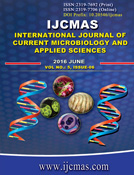


 National Academy of Agricultural Sciences (NAAS)
National Academy of Agricultural Sciences (NAAS)

|
PRINT ISSN : 2319-7692
Online ISSN : 2319-7706 Issues : 12 per year Publisher : Excellent Publishers Email : editorijcmas@gmail.com / submit@ijcmas.com Editor-in-chief: Dr.M.Prakash Index Copernicus ICV 2018: 95.39 NAAS RATING 2020: 5.38 |
Microorganisms especially Fungi are well known for their capability to excrete industrially important enzymes into the environment. In this purposed study, thirty four mesophilic as well as thermophilic fungal species were isolated from different sources like, decaying wood, decaying kinnow fruit, compost and soil. The isolated species were then purified and qualitatively selected for their cellulolytic, lignolytic and hemicellulose degrading potential using agar plate assay method. Carboxy Methyl Cellulose was used as substrate for cellulase activity, xylan was used as a substrate for xylanase activity; Remazol brilliant blue (RBB) dye and guaiacol were used as substrate to evaluate lignolytic activity in the isolated fungi. A total of 15 fungal isolates and the standard cultures namely Phanerochaete chrysosporium MTCC 787, Trichoderma reesei MTCC 164, T. harzianum MTCC 792, Coriolus versicolor MTCC 138, Pleurotus ostreatus MTCC 142, Aspergillus oryzae NCIM 1212, Penicillium roquefortii NCIM 712, Thermoascus aurantiacus MTCC 375, Humicola fuscoatra MTCC 1409 showed redness zone on guaiacol. Two mesophilic isolates namely A4 and A5; two thermophilic isolates A25 and A31 are the potential cellulose, hemicelluloses and lignin degraders which can further be used for enhancing biogas production. Among standard cultures P. chrysosporium and T. aurantiacus produced remarkable amounts of lignocellulolytic enzymes.
 |
 |
 |
 |
 |